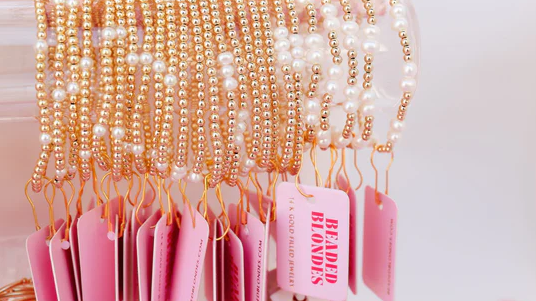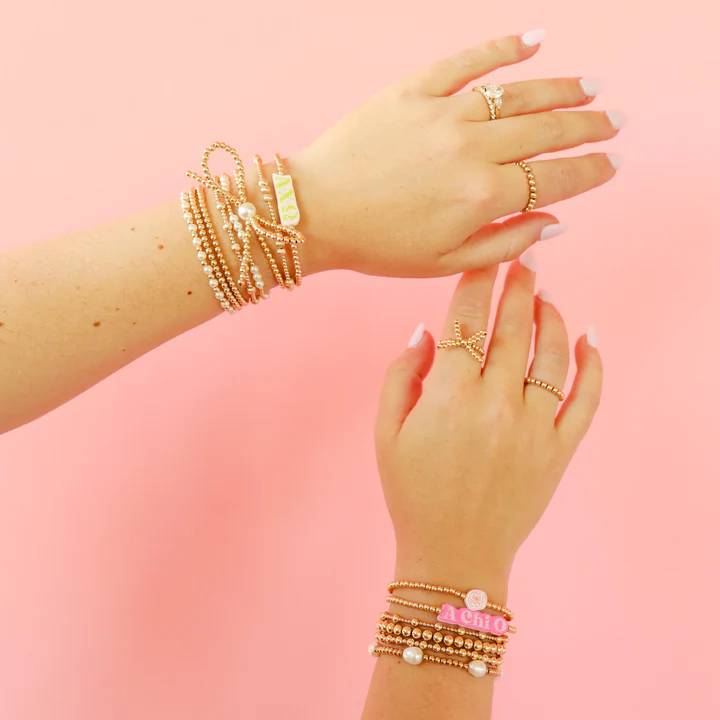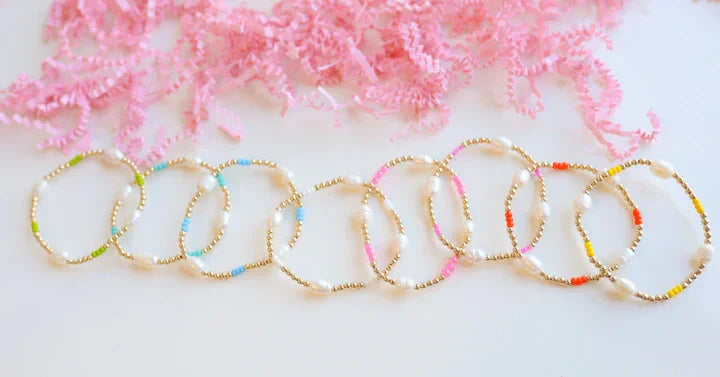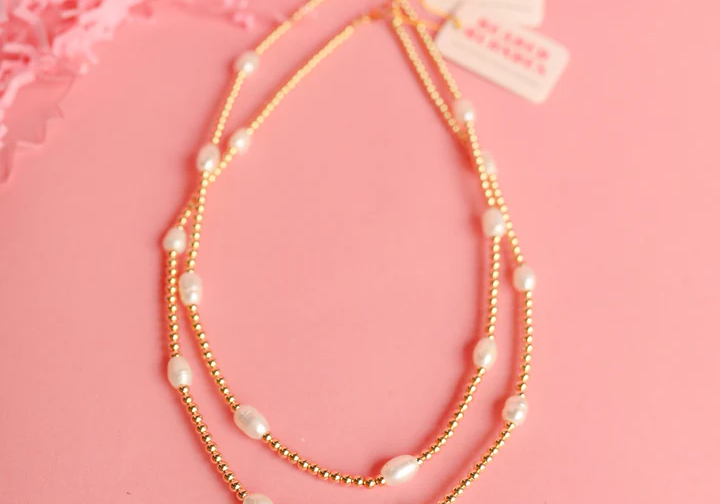Gold jewelry has always been synonymous with elegance and value. But it can get confusing with terms like 14K, 18K, and pure gold tossed around. What makes 14K gold so popular, and why does it strike the perfect balance between beauty and practicality?
If you've ever wondered about gold purity, why some gold jewelry is more durable than others, or how much 14K gold is worth, you're in the right place. Let’s break it all down and explore why 14K gold is a favorite for creating fine jewelry.
Understanding 14K Gold
So what is 14k gold exactly? When it comes to pure gold, 14K gold stands out as an excellent middle ground. Treat yourself to the warmth and sophistication of gold without worrying about fragility. This durable gold has you covered. A sweet spot is hit by pairing gold with other metals: strength meets affordability, making it a phenomenal bargain.
Definition of Karat and Gold Purity
Gold purity is measured in karats (K), with 24K representing 100% pure gold. However, pure gold is extremely soft and unsuitable for everyday wear. Instead, it’s alloyed with other metals like copper, silver, zinc, or nickel to make gold more durable. 14K gold contains 58.3% pure gold and 41.7% other metals.
Comparison With Pure Gold and Other Karat Grades
Gold comes in various karat grades, each offering different levels of purity and durability:
- 10K: Contains 41.7% pure gold. It’s the least expensive and most durable but has a paler yellow hue and may cause skin irritation due to higher alloy content.
- 14K: With 58.3% pure gold, it balances durability, affordability, and beauty, making it ideal for wearable jewelry.
- 18K: Contains 75% pure gold, offering a richer yellow hue but is softer and more prone to scratches.
- 24K: The purest form, at 100% pure gold. While stunning, it’s too soft for most jewelry applications.
Generally speaking, 14K gold’s alloy composition provides the perfect mix of strength and elegance for daily wear.
Characteristics of 14K Gold
One of the key reasons 14K gold is so popular is its versatility. It is strong enough for daily wear, offers a variety of beautiful colors, and allows jewelers to craft intricate designs. Whether you're looking for beaded jewelry or wedding rings, 14K gold can adapt to any style or purpose.
Color Variations
Versatility in color is one of the most appealing aspects of 14K gold. While most pieces use yellow gold, jewelers can create a wide variety of jewelry by mixing pure gold with different metals and getting different hues.
Yellow Gold
Yellow gold is the most traditional and recognizable form of gold, admired for its rich, warm color that radiates a classic gold appearance. A hint of copper, a dash of silver, and pure gold unite to forge yellow gold. It exudes the warm, sunny tones of the precious metal. With copper taking the reins on strength, silver infuses a mesmerizing sheen, viola! Yellow gold is created. The careful blend of these metals yields yellow gold, making it as tough as it is attractive.
White Gold
Modern romance reigns supreme with white gold, an ultramodern aesthetic hot off the press for those glamorous engagement and wedding rings. Its silvery-white appearance is achieved by alloying pure gold with white metals like nickel, palladium, or silver. This blend gives white gold its unique color and enhances its durability, making it an excellent choice for everyday wear.
Rose Gold
Rose gold, also known as pink or red gold, is beloved for its romantic and vintage appeal. This charming hue is created by blending pure gold with copper, with the level of copper determining the depth of the color. Higher copper content produces a deeper red tone, while lower amounts create a softer pinkish hue. Some alloys also include a small amount of silver to balance the color and improve the metal's malleability.
Other Unique Alloys: Blue and Purple Gold
Blue gold is a rare and striking alloy that combines gold with metals like iron or cobalt. It's less common than yellow, white, or rose gold, making it an exclusive choice for those seeking unconventional and artistic jewelry. Its bold hue pairs well with contemporary styles and can be accented with complementary gemstones like sapphires or diamonds to enhance its striking appearance.
Purple gold, also known as amethyst gold, is another rare and visually captivating alloy. It’s created by combining gold with aluminum, resulting in a violet hue that is both bold and delicate. While purple gold is beautiful, its brittleness limits its use in intricate designs or fine settings. It is often crafted into larger, simpler shapes or used as accents in jewelry to avoid the risk of damage.
14k Gold Durability and Strength
One of the standout qualities of 14K gold is its impressive durability. Unlike higher-karat gold, which contains a higher percentage of pure gold and is softer, 14K gold includes a blend of harder metals like copper, silver, zinc, or nickel.
This durability is why 14K gold is so popular for engagement rings, wedding bands, and other jewelry meant to be worn daily. Whether it’s a 14k gold bead bracelet exposed to various activities or a diamond ring that endures constant use, 14K gold can maintain its beauty for years with minimal maintenance.
Malleability and Versatility of 14k Gold
While 14K gold is tough, it doesn’t sacrifice malleability, which is a crucial property for jewelry making. The alloy composition strikes the ideal balance, allowing jewelers to mold and shape the gold into intricate designs without compromising its structural integrity. This characteristic makes 14K gold a favorite for creating both elaborate and minimalist jewelry pieces.
For example, 14K gold is pliable enough to allow detailed beadwork in handmade beaded jewelry or ornate engravings on engagement rings. At the same time, its durability ensures these designs remain intact over time. This versatility makes 14K gold suitable for a wide range of jewelry styles, from delicate filigree to bold statement pieces.
Additionally, 14K gold’s compatibility with gemstones enhances its adaptability. Jewelers can create secure settings for diamonds, emeralds, sapphires, and other precious stones without worrying about the metal being too soft to hold them firmly in place. Whether it’s a pavé diamond band or a solitaire engagement ring, 14K gold provides a reliable and stunning foundation for any design.
Advantages and Disadvantages of 14K Gold
A beautiful piece of gold jewelry should check all the right boxes: it should catch the eye, stand the test of time, and fit your budget.
14K gold checks all the right boxes, earning it a spot as one of the most coveted materials in jewelry crafting. Many marvel at this gold alloy, but what's the reality behind the glamour, and are there consequences to its use?
Advantages
14K gold strikes the perfect balance between luxury and value. Its 58.3% gold content keeps it more affordable than 18K or 24K gold, while adding other metals enhances its durability.
The beauty of 14K gold lies in its adaptability. Whether you prefer the traditional warmth of yellow gold, the sleek sophistication of white gold, or the romantic charm of rose gold, 14K gold delivers.
Disadvantages
One of the main disadvantages of 14K gold is its lower purity compared to 18K or 24K gold. With only 58.3% pure gold, it doesn’t have the same richness or deep golden hue as higher-karat options.
Because 14K gold is an alloy, it often contains metals like nickel, copper, or zinc. While these metals improve strength and color variety, they can cause allergic reactions in some individuals, particularly those with nickel sensitivities.
14K Gold Jewelry
Look no further than 14K gold for jewelry that radiates luxury. It's perfect for everyday beaded treasures or forever commitment pieces like engagement rings. Tough enough for everyday wear yet elegant enough for a special night, this accessory wins on both fronts.
Choosing 14K Gold for Engagement Rings, Beaded Jewelry and Fine Jewelry
For pieces that command attention, 14K gold is the clear winner. It imparts subtlety and refinement to even the most ornate beaded designs. 14k gold elevates humble engagement rings into modern heirlooms. Don't settle for dull, fragile jewelry; this outstanding option blends long-lasting durability with fresh, striking designs that never go out of style and are priced reasonably.
Engagement Rings
For engagement rings, 14K gold provides a robust yet stunning setting that can securely hold precious stones like diamonds, emeralds, or sapphires. Its alloy composition ensures it is strong enough to handle everyday activities without bending, scratching, or tarnishing easily.
Beaded Jewelry
When it comes to handmade beaded rings, bracelets, or necklaces, 14K gold is a standout choice for both its practicality and aesthetic appeal. Beads crafted from 14K gold add a touch of luxury to any design, while the metal’s durability ensures that the jewelry can be worn frequently without losing its shine or shape.
Gold-filled beads are often blended with other materials — think precious stones, lustrous pearls, or even recycled glass — to craft truly show-stopping pieces that capture the eye. Working with 14K gold, artisans can easily add delicate flourishes to their designs, creating truly breathtaking pieces that showcase their skill.
Fine Jewelry
Beyond engagement rings and beaded designs, 14K gold is widely used in fine jewelry such as necklaces, bracelets, earrings, and pendants. Its affordability compared to higher-karat golds allows for larger, more elaborate designs without compromising on quality or appearance.
For instance, a statement necklace or a pair of chandelier earrings crafted in 14K gold can achieve the luxurious look of fine jewelry at a more accessible price point. The versatility of 14K gold also means it can adapt to various styles, from modern minimalist to vintage-inspired pieces.
14K gold is a fantastic choice for creating engagement rings, handmade 14k gold-filled jewelry, and other fine pieces. Its balance of strength, affordability, and beauty allows it to meet the demands of daily wear while maintaining its elegance and charm. Whether you’re selecting a lifelong symbol of commitment or a custom-made work of art, 14K gold offers durability and timeless appeal to make your jewelry truly unique.
Identifying and Authenticating 14K Gold
When purchasing gold jewelry, ensuring its authenticity and quality is essential to making an informed investment. With 14K gold being one of the most popular choices for fine jewelry, knowing how to identify and authenticate it can save you from buying counterfeit or low-quality pieces.
Understanding Hallmarks and Stamps
One of the easiest ways to identify authentic 14K gold is by checking for hallmarks or stamps on the jewelry. These markings, often engraved in discreet areas such as the inside of a ring band or on the clasp of a necklace, indicate the purity of the gold. Common hallmarks include:
- “14K” or “14KT”: These are standard indicators that the piece is made of 14-karat gold, containing 58.3% pure gold.
- “585”: This numerical marking is used internationally to denote that the gold content is 58.5%, which is equivalent to 14K gold.
In addition to purity marks, many pieces of jewelry made from gold also include other hallmarks, such as:
- Manufacturer’s Marks: These symbols or initials represent the jewelry maker or company.
- Country of Origin: Some pieces, especially those meant for export, may include a stamp indicating where the jewelry was made.
It’s important to note that hallmarking standards vary by country. In the United States, the Federal Trade Commission (FTC) requires accurate karat markings but doesn’t mandate stamping on all gold items. However, reputable jewelers ensure their products are marked for transparency and trust.
How to Spot Fake Gold and Verify Authenticity
While hallmarks provide a good starting point, they are not foolproof, as counterfeiters may falsely stamp items. Here are some steps to further verify the authenticity of gold:
- Inspect the hallmark carefully. Real gold hallmarks are cleanly engraved and often require magnification to see clearly. Smudged or uneven markings may indicate a fake.
- Check for tarnish. Pure gold does not tarnish. If you notice discoloration, especially in areas of frequent wear, the item may be gold-plated rather than solid gold or gold filled.
- Conduct a magnet test. Gold is not magnetic. If the jewelry is strongly attracted to a magnet, it likely contains other metals or is gold-plated.
- Ask your jeweler to use the acid test. They can apply a small amount of nitric acid to the jewelry to determine its gold content. Genuine gold will resist the acid, while lower-quality metals may react and discolor.
- Weigh the jewelry. Gold is denser than most other metals. Comparing the weight of a suspected piece to a known gold item of similar size can help confirm its authenticity.
- Get professional testing. For complete certainty, take the jewelry to a reputable jeweler or appraiser. They can use tools like X-ray fluorescence (XRF) machines to analyze the exact gold content without damaging the item.
The best, easiest, and most cost-effective way to ensure you are purchasing gold pieces is to choose reputable jewelers or certified retailers. They provide guarantees and are more likely to sell authentic, high-quality products.
Be Wary of Suspiciously Low Prices
If a deal seems too good to be true, it probably is. Counterfeit or low-quality gold jewelry is often sold at prices significantly lower than market value. Research the current price of gold and understand that the craftsmanship and design also contribute to the cost of a piece.
By familiarizing yourself with these authentication methods, you can confidently choose 14K gold that meets your quality, value, and beauty expectations. Investing in verified gold ensures you enjoy its elegance and durability for years to come.
Care and Maintenance of 14K Gold
Proper care ensures your 14K gold jewelry stays beautiful for years. You can preserve its shine and durability with the proper cleaning techniques and storage habits.
Cleaning Tips and Best Practices
Keeping your 14K gold jewelry clean is essential to maintaining its brilliance. Here’s a step-by-step guide to safely clean your pieces:
- Prepare a Soaking Solution: Mix a few drops of mild dish soap with warm water in a small bowl. Avoid using overly hot water, as it can loosen stones in specific settings.
- Soak the Jewelry: Place your 14K gold items in the solution and let them soak for about 15–20 minutes. This helps loosen dirt and oils that accumulate over time.
- Use a Soft Brush: Gently scrub the jewelry with a soft-bristled toothbrush or a jewelry cleaning brush. Pay special attention to crevices and intricate details where dirt builds up.
- Rinse Thoroughly: After cleaning, rinse the jewelry under lukewarm water to remove soap residue. Be sure to do this over a secure area, such as a strainer or bowl, to prevent losing small pieces down the drain.
- Dry with Care: Pat the jewelry dry with a soft, lint-free cloth. Allow it to air dry completely before storing to prevent moisture buildup.
Consider using a professional jewelry cleaning solution formulated explicitly for gold for heavily tarnished or intricate pieces. If your 14K gold has gemstones, avoid soaking and use a damp cloth to clean around the stones instead.
Preventing Scratches and Dents for Long-Lasting Jewelry
To keep your 14K gold jewelry pristine, minimizing the risk of scratches and dents is essential. Here are some best practices:
- Store Jewelry Separately: Always store your 14K gold pieces in a jewelry pouch or separate compartments in a jewelry box. This prevents them from rubbing against other items, which can cause scratching.
- Use Protective Cases: For added protection, use padded or lined cases when traveling with your jewelry. This prevents unnecessary movement and reduces the risk of damage during transit.
- Avoid Wearing During Activities: Remove your 14K gold jewelry before engaging in strenuous sports, gardening, or heavy lifting activities. These activities can expose the jewelry to impacts and abrasions.
- Apply Beauty Products Before Wearing: Lotions, perfumes, and hairsprays can dull gold’s shine over time. Apply these products before putting on your jewelry to avoid residue buildup.
- Schedule Routine Maintenance: Take your 14K gold pieces to a professional jeweler every year or two for inspection and cleaning. They can polish away minor scratches and ensure settings remain secure.
By following these simple yet effective care practices, your 14K gold jewelry can remain as stunning and durable as the day you bought it.
Market Value and Investment
The value of 14K gold depends on its durability and market trends. Factors such as the current price of gold, economic conditions, and demand for gold jewelry all play a role in determining its worth. Additionally, the quality of craftsmanship and the inclusion of gemstones can significantly impact the overall value of a piece.
Price Comparison to Other Gold Purities and Market Trends
14K gold’s price is lower than that of higher-karat gold, such as 18K or 24K, because of its lower gold content. However, its affordability and strength make it a practical choice for everyday wear and fine jewelry.
On average, 14K gold is approximately 20–35% lower than 18K gold and significantly more affordable than 24K gold. The exact price depends on the weight of the gold, the current market rate, and the additional metals used in the alloy.
Investment Value and Potential for 14K Gold
While not as valuable as higher-karat gold, 14K gold’s durability and versatility make it a worthwhile investment for wearable jewelry and fine pieces. Its strength ensures that it holds up well over time, reducing the risk of damage and maintaining its resale value.
For those interested in gold as a functional investment, 14K gold combines beauty with practicality, making it a smart choice for everyday wear that retains its inherent value. Over time, the increasing price of gold can also enhance the worth of 14K gold jewelry, especially well-crafted or unique pieces.
Shine Bright with Beaded Blondes
Looking for the perfect blend of beauty and durability in your jewelry? Beaded Blondes offers stunning handmade designs featuring 14K gold beads that are as unique as you are. Whether it’s beaded bracelets, rings, or other fine pieces, our collection is crafted with care to suit every occasion. Explore our collection today and find your next favorite piece.





